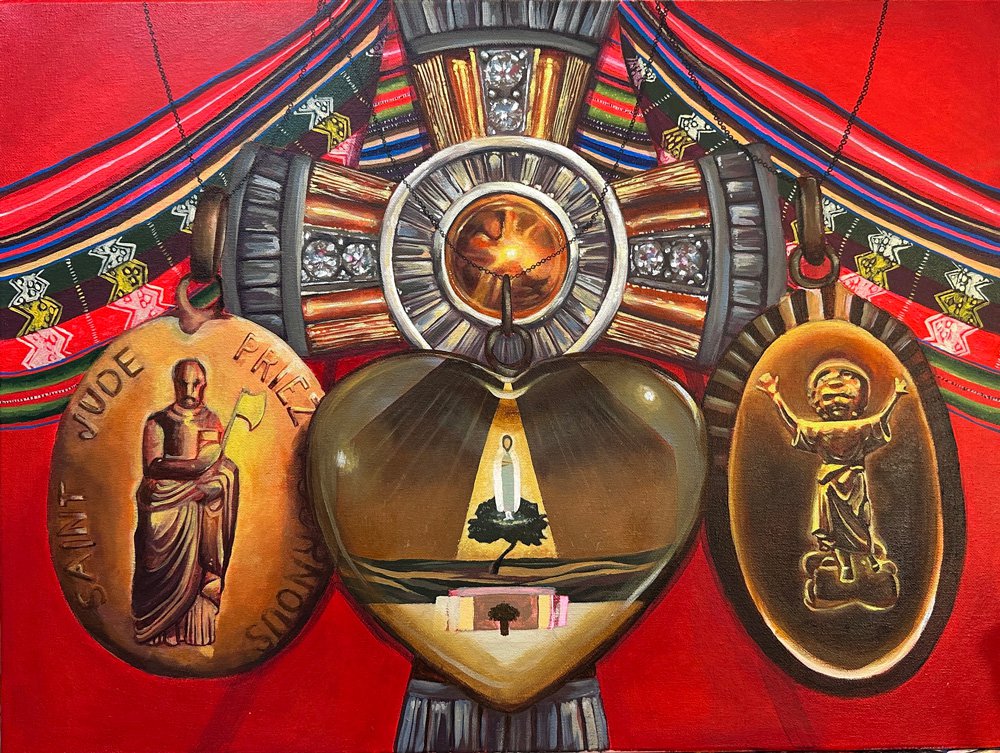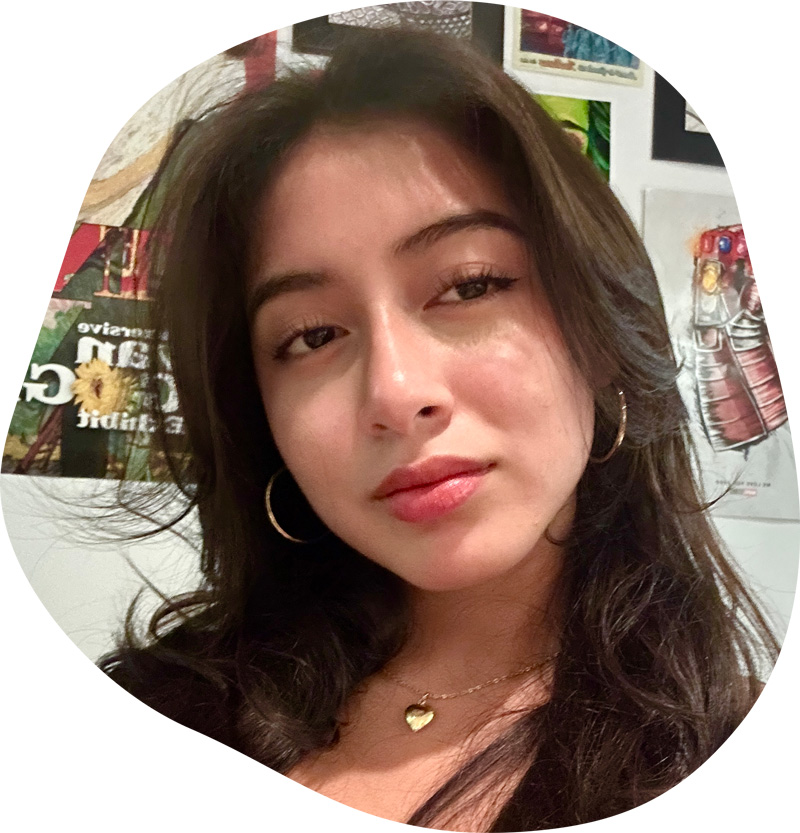

Mi Bodegón

Height: 18" x Width: 24" | Material(s): ): Imitation of gold, jewels and Peruvian artisan blanket (a manta) using acrylic on canvas | Process(es): Grand scale of jewelry = importance & power to heal us and connect us emotionally to our ancestors | Idea(s): The power of heirlooms that we wear every day to heal, comfort, and connect us to loved ones. | Curatorial Note: The use of traditional colors and designs was an effective way to home in to the sentiment of traditional healing methods.
Sophia Basaldúa
Does your work reference or draw on a contemporary or historical artmaking style, practice, or tradition? If so, please explain.
The style I reference is the Bodegón style; however, it varies in that typical Bodegón paintings show food as still life, while my version shows a collection of family heirlooms meaningful to me. It references the religion and culture of Peru. The textile in the background is a traditional Peruvian manta. The four pendants are family heirlooms influenced by Catholic beliefs. One is a cross encrusted with jewels, while the exterior pendants depict Saint Jude and Baby Jesus. The center pendant has no religious engravings; it instead shows a reflection of the church that my family has attended since their arrival to this country where many familial ceremonies were held, including my grandparents’ memorials.
How did this artwork relate to your sustained investigation inquiry?
This piece specifically tackled healing from loss with the overall sustained investigation being how healing varies between cultures, ages, and personal experiences.
I drew inspiration from my family's Peruvian culture and began investigating medicinal and herbal remedies that I grew up with.
Material(s): Material exploration of metal foil aluminum, Procreate. Process for image. | Process(es): Tried fake metal; it didn't reflect colors I wanted. Gold studies to find how to make gold more vibrant
How did you choose your inquiry?
I drew inspiration from my family's Peruvian culture. Their medicinal and herbal remedies were visible sources of inspiration, but when I expanded my focus to the overall topic of healing, I was able to tackle invisible cures like, “Sana, sana, colita de rana” (“heal, heal, little frog’s tail,” a Hispanic nursery rhyme) or family heirlooms.
Describe how your inquiry evolved as your sustained investigation developed.
My inquiry evolved the more I realized what healing meant to me. Growing up in a Hispanic family, I watched as relatives always had a traditional solution to most ailments. Caring for people when they are sick and physically or emotionally hurt is their love language. They always want to make sure you are alright, and the more I looked, the more I took notice of the various remedies my family uses to heal both the body and the soul.
Material(s): Procreate, my photo of my Grandpa's necklaces and the church of their funerals. Process for image. | Process(es): Compositional studies of the necklaces, changed from church being focal point to the jewelry instead
How did you practice or improve your written inquiry statement as your portfolio developed?
The first thing was to find what I was even interested in researching. The reason I chose healing was because of the countless questions I could ask about it and answer through my art. However, it was after I had all my pieces that I really solidified my actual inquiry statement. I had the idea—healing. Now I had to take a final look at my art and write how it ultimately branched out. When it came to writing it, I had to come up with the why. Why did I even paint this? Why did I use those materials? Why did I change something? Ultimately, I broke my art down in ways I didn’t even see originally but did subconsciously.
How did you practice or improve the written statements accompanying each artwork in your portfolio (ideas, materials, process(es), and citations) to best communicate your intentions?
When I first started writing, I was encouraged to simply spill out everything about each painting onto a Google document: the how, the what, and the why for each piece. Seeing it all written out helped me find the core of what I wanted and needed to say,allowing me to simplify it to its most concentrated form and give the most amount of information with as few words as possible.
How did your art teacher support your artistic development?
Mrs. Procaccino pushed me to break apart and analyze every part of the process. At each step, I was told to take pictures, to write down every thought that came to mind, and to constantly test out things even if I didn’t think it would work. Not only that, but she also pushed me to experiment with color, light, and composition, expanding from portraits to this final piece being only inanimate objects, where I learned to paint metals and fabric. All this helped me expand my pieces further than I'd thought possible.
How did your school leadership (principal, assistant principal, guidance counselor, etc.) support your growth as an art student? This could be classroom visits, attending art shows, talking to you about your goals, etc.
Throughout high school, I’ve received support from every corner. Mrs. Procaccino was my mentor for AP Art, guiding me through every step of the independent study. Dr. Ruggieri and Mr. Stumbers have supported and helped develop my art skills since freshman year. My school's art director, Mrs. Longo, submitted my art to exhibits. The assistant principal Mrs. Huynh, my counselor Mrs. Hinkis, and the principal Mary Asfendis were always free to offer guidance, and even when passing by in the hallway, would congratulate me and want updates on whatever I was doing next. These people have been at countless art events, always happy to help, and have encouraged me at every step of my art journey.
What is your advice to other AP Art and Design students?
Take breaks and gain inspiration. Initially I didn't think I would cover the topic of loss for my portfolio. I had plans to stick to more physical remedies like tea and ointments, but it was when I started to open my eyes to small actions that I changed my mind. I saw how when I missed my grandfather I would fidget with my necklace, and then I noticed how my sister did the same. How we would rarely take off the necklaces or when we did it was to make sure we wouldn't lose them on a roller coaster or at the beach. I realized it was our way of holding the memory of him close and it is what jump-started this painting.
Amanda Procaccino
Westfield High School, Westfield, NJ, USA
Teacher Statement
Teacher Statement
The AP Art and Design course supports inquiry-based personalized learning in the sustained investigation portfolio component. What strategies helped you guide students through inquiry?
I tell my students that the strongest work will come when it has a genuine connection to them. I consistently pose my favorite question, “What if?” and strive to create an environment where students aren’t afraid to take risks. I encourage them to think about the total experience they want for the viewer to help them get to the core of what they are trying to say through their art.
How did you scaffold writing into the art-making and thinking processes?
I give my students a small sketchbook at the beginning of the year and encourage them to take it wherever they go to write down inspiration or ideas as they strike them, journal, sketch, etc. I also have the students write an initial artist statement that we revisit every month, so they are constantly revising it as their investigations grow and evolve.
How did you support skill development AND inquiry in the AP Art and Design curriculum?
I encourage students to dedicate plenty of time to material exploration to help them discover ways of using materials and their properties to better convey their ideas. This helps students refine and expand their skills while still exploring their inquiry. Emphasizing the artistic process supports critical thinking and the creation of more meaningful ideas.
Sophia’s investigation was a captivating journey through her Peruvian heritage. Her work delved into the cultural nuances that shaped her identity and the strong woman she is today. Through her insightful research, I learned about the strong intergenerational bonds and family values within her Peruvian heritage.
Material(s): Research of Peruvian church altar, photos of my blanket, photos of mantas. Process for image. | Process(es): Figuring out the background. Red inspired by church develops into using detailed red Peruvian blanket.
Mabel Huynh
Assistant Principal and AP Testing Coordinator
Westfield High School, Westfield, NJ, USA
Leader Statement
Leader Statement
What are you most proud of regarding your school’s AP Art and Design program, student, and teacher?
I am incredibly proud of how our school’s mission to help all students reach their highest potential comes to life through our Visual and Performing Arts (VPA) program. While we do not offer traditional AP Art courses, we provide students with meaningful opportunities to pursue their passions through programs like Independent Study. This approach challenges students to grow intellectually, professionally, and personally, extending their learning beyond the standard curriculum. A perfect example of this is Sophia's exceptional Independent Study and her final presentation. Watching her speak about each piece in her art portfolio, sharing her creative process, and reflecting on her progress was an inspiring moment. Sophia's work demonstrates the power of self-directed learning and the importance of creating opportunities for students to thrive in their areas of passion. Sophia's success reflects not only her dedication but also the commitment of her teacher and mentor, who supported and guided her throughout the process. Together, they exemplify what can be achieved when students are given the freedom, resources, and encouragement to reach their full artistic potential.
What do you do to support visual arts programming in your school?
At Westfield High School, we actively support visual arts programming by providing diverse opportunities for students to explore their artistic talents. We offer alternative pathways, such as the Independent Study program, to meet the needs of students whose interests extend beyond traditional courses. This program pairs students with mentors, enabling them to engage in self-directed, credit-bearing learning experiences that foster both creativity and discipline. As the school leader and AP coordinator, I have supported initiatives that expand opportunities for our students, including facilitating the submission of AP Art portfolios for the first time in our school’s history. This milestone highlights our commitment to rigorous and meaningful programs that support student growth while aligning with educational goals. Additionally, we encourage students to showcase their talents in various ways, both within and beyond the school community.
What is your advice to other school leaders on how to support an AP Art and Design program?
Empower students to reach their highest potential by honoring their unique interests and talents. Collaborate closely with the Visual and Performing Arts supervisor and art teachers to identify and develop diverse pathways for artistic exploration. This might include expanding course offerings, establishing Independent Study programs, supporting AP portfolio submissions, or creating other innovative opportunities. Above all, prioritize flexibility, creativity, and student-centered approaches to ensure that all learners have access to meaningful and enriching visual arts experiences.

Sophia Basaldúa



